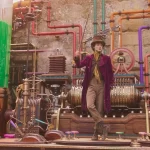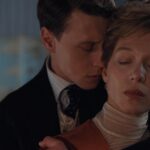Unquiet Americans: Modern Romance, by Aaron Pinkston
Albert Brooks is a strange figure in American comedy. Though primarily known as an actor (in part because of his career resurgence with the release of Drive), he made seven features as a writer-director. A few of his films have gone on to be respected, but none of them were big hits at the time and haven’t really latched on as rediscovered or overlooked gems. Only hardcore fans of Saturday Night Live may know that Brooks got his start as a filmmaker with a number of filmed segments during the show’s first season — sort of a prototype of the digital shorts that later became a staple of the show’s success. His varied career also includes successful comedy albums, notable voicework in Finding Nemo and The Simpsons, a New York Times bestselling dystopian sci-fi novel, and a thriving presence on Twitter. Now that Brooks is probably more popular than ever, it is a perfect time to look back at his work when his voice was the most clear and his instincts the most daring. His second feature, 1981’s Modern Romance, is a very good place to start.
In the film, Brooks plays a successful film editor named Robert Cole who is working on a terrible sci-fi picture while in the middle of a romantic crisis. Robert dumps his longtime girlfriend Mary Harvard in the opening scene, but quickly realizes that he can’t live without her. We don’t see any of their relationship before the breakup, but we come to understand that this isn’t their first split — they’ve, in fact, done this many times before they wind up with each other again. And they do it many times over the course of the film.
Outside of Cole’s neurotic tendencies, the film plays incredibly straight. If you stack Modern Romance up with last week’s 1941, this doesn’t have nearly as many laughs. In fairness, it seems to be going for completely opposite goals. Modern Romance is trying to tell a romantic story with as much reality as possible, even at the expense of packing in jokes. Because of this, most of the film’s humor comes away from the romantic plotline and instead within his strange working environment (real life filmmaker James L. Brooks, who gave Albert Brooks his most important role as an actor in Broadcast News, plays a memorable role as the filmmaker of the god-awful looking sci-fi film within Modern Romance). What humor the film does have comes mostly through Brooks’ overplayed neuroticism, something like a less intellectually-minded Woody Allen. This is seen in many extended scenes of Robert dealing with his loss by shuffling around his house, doing practically nothing.
This is essentially a romantic comedy, however, though it doesn’t rely on any of the genre’s natural trappings. The film isn’t even particularly romantic. Robert and Mary are surely a compatible couple with natural attraction and similar social status, but we aren’t really given much reason for them to stick together. I suppose we want to see Robert and Mary together by the end of the film because this is a movie and that is how movies work, even when all we see is their bickering and Robert’s manipulation. Robert isn’t particularly likeable, but he is relatable. Because we see the relationship entirely from his perspective (more on that later) and, more importantly, because of the realistic tone of the film, it is really easy to look at our own relationships and see similar intricacies, including the jealousness and obsessions that we don’t wish to see in ourselves.
At one point, Mary asks Robert if he is confusing his feelings as real love vs. movie love. Being a film editor, Robert’s job is literally to rearrange and work something terrible in hopes of making it great. He clearly takes the same approach in his relationship with Mary, continually editing the mistakes any normal person makes to get her back. Certainly, his overly-obsessive behaviors have a movie-like sheen to them, allowing his picky and jealous behavior from being unacceptably creepy. In this way, the film plays with audience expectations of movie romance while also trying to portray an on-screen relationship with verisimilitude. The effect is strange and appreciated, though it perhaps makes a better experiment than film.
The biggest difficulty Modern Romance has, keeping it from being an oddball masterpiece, is its sense of perspective. Brooks dominates the film, appearing in a good 90% of it and is our only real insight into the central relationship. The film would feel more complete, and maybe even funnier, with a better sense of Mary. She wouldn’t necessarily need to match Robert’s tics, but she is barely a character as she stands — really only a perfect object to drive Robert’s obsessive personality. From what we see, she seems like a normal, adjusted, sane person, so why does she tolerate his craziness when it only makes them both unhappy? This question is of course addressed by many real-world relationships, but it isn’t so interesting in a movie. One might argue that keeping her motivations mysterious adds something to the film’s somber humor or truly says something about modern romance in the real world, but I just don’t see it. While this may be the intention the film, it is just as likely that Modern Romance is the vision of a single auteur who writes, directs and stars in it and that this is reflected in the film’s status.
Modern Romance’s balance of real-life romance and movie romance is a worthy and sometimes fascinating goal. It is a weird change of pace for this series in particular, which has had a string of bigger, broader, goofier comedies. By 2014, romantic comedies have morphed into a cookie-cutter, immediately recognizable genre, but that wasn’t quite the case when Modern Romance was released. Using the styles and sensibilities of the New Hollywood movement with a singular, auteurist drive, the film is probably more important than its reputation. Even while its serious narrative problems keep it from being a masterpiece, it is worth remembering or perhaps discovering.





























